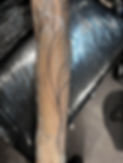

After Care
Congratulations on your new tattoo!
Now that you have a beautiful piece of art on your skin, it's crucial to take proper care of it to ensure it heals well and maintains its vibrancy. Tattoo aftercare is an essential part of the process, as it helps prevent infections, reduces the risk of complications, and ensures that your tattoo looks as stunning as the day it was done.
By following these aftercare guidelines, you can protect your new tattoo and keep it looking its best for years to come!
What should you do?
-
Keep the Bandage On: I will cover your tattoo with a cling film. Leave this on for max four hours, as recommended by me. This protects the tattoo from bacteria and prevents irritation. But we cant keep it closed, because it needs to breathe to get healed.
-
Wash Your Hands: Before touching your tattoo, always wash your hands with antibacterial soap to avoid introducing bacteria to the area.
-
Clean the Tattoo: After removing the bandage, gently wash the tattoo with lukewarm water and a mild, fragrance-free anti-bacterial soap. Avoid using a washcloth or sponge. Pat the area dry with a clean, soft towel. Please keep doing it every morning and evening for a week.
-
Apply Aftercare Ointment: After cleaning, apply a thin layer of a recommended tattoo aftercare ointment (Bepanthol Baby, Bepanthen tattoo or La Roche-Posay Cicaplast B5+). Avoid using petroleum jelly and other oils as it can clog pores or cause an infection.
What are the other important things?
-
Moisturize Regularly: Keep the tattoo moisturized by applying your creme minimum 5 times a day with a very thin layer. Ensure your skin stays hydrated but not overly covered with the cream. If you see that your skin gets dry frequently, there is no problem to apply cream more frequently but with very very thin layer.
-
Avoid Sun Exposure: Keep your tattoo out of direct sunlight. UV rays can fade and damage your new tattoo. Once healed, after 2-3 weeks,always use sunscreen +50 spf to protect it.
-
Wear Loose Clothing: Avoid tight clothing that might rub against the tattoo during healing process. Opt for loose, breathable fabrics to prevent irritation.
-
Do Not Pick or Scratch: Your tattoo will start to scab and peel as it heals but it will be such thin layer that you might not notice it. It's important not to pick or scratch at the scabs as this can cause scarring and ink loss.
-
Avoid Submerging in Water: Stay away from swimming pools, hot tubs, spas and baths. Quick showers are fine, but prolonged exposure to water can damage the tattoo. Avoid using shower gels/ body scrubs during healing process.
-
Do not use alcohol-based products on your tattoo for 15 days. You should pay attention to things such as disinfectant, perfume, deodorant, etc.
-
You can exercise but not first 5-6 days. Because your body will try to get rid of the ink already and we dont want to support this with sweating. And please do not forget that you need to keep your skin clean and moisturized. (for example no hot yoga or no climbing or no swimming or the no exercises on matte, non of the sports that you sweat a lot )
-
Sounds difficult but it s not. You can do it ! Don't forget that the first two- three weeks are the most important time to get good healed results. You can turn back to your normal routine after 2 to 3 weeks.
-
If you think that you need a touch-up appointment, please share the photos of your healed tattoo (with main cameras in natural light) and we can decide together.


What are the other important things?
Tattoo Healing Process and Variations Based on Skin Types
Tattooing involves injecting ink into the dermis layer of the skin, which causes trauma to the skin surface. During the healing process, the body activates its natural defense mechanisms to repair the skin. As the tattoo heals, the epidermis (the outer layer of the skin) begins to form a scab. This scabbing is a natural part of the healing process, as the skin tries to protect itself from infection and external damage. However, the way this healing unfolds can vary greatly depending on the individual’s skin type, moisture balance,age and how well they care for their skin post-tattoo.
Impact of Scabbing on Tattoo Appearance
As mentioned, the scabbing process can affect the final look of the tattoo. If the scabs are too thick or dry out too much, they can pull ink from the dermis, leading to broken or faded lines in the tattoo. This is particularly common in tattoos with fine details or thin lines, where the loss of even a small amount of ink can significantly impact the design’s overall clarity.
The key to minimizing this is to manage the scabbing process carefully. Overly dry skin can exacerbate scabbing and cause excessive ink loss, so keeping the tattoo area hydrated is essential. However, it’s also important to avoid over-moisturizing, as too much moisture can delay healing or cause the scabs to become too soft and prone to infection
